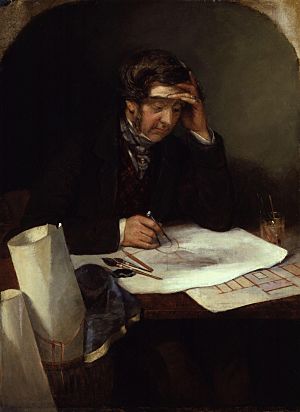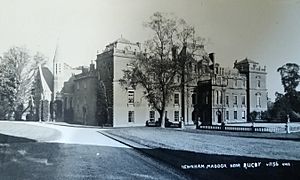Thomas Henry Wyatt facts for kids
Quick facts for kids
Thomas Henry Wyatt
|
|
|---|---|

Thomas Henry Wyatt by George Landseer
|
|
| Born | 9 May 1807 Loughglinn House, County Roscommon
|
| Died | 5 August 1880 (aged 73) London
|
| Nationality | British |
| Occupation | Architect |
| Awards | Royal Gold Medal (1873) |
Thomas Henry Wyatt (born May 9, 1807 – died August 5, 1880) was a very busy and important architect from Britain and Ireland. He designed many buildings during his career. He was even chosen to be the President of the Royal Institute of British Architects from 1870 to 1873. In 1873, he received the Royal Gold Medal for Architecture, which is a very high honor. While he was alive, people saw him as a reliable and respected architect.
Contents
- About Thomas Henry Wyatt
- Wyatt's Career as an Architect
- Buildings Designed by Wyatt
- Buildings in Wiltshire
- Buildings in Monmouthshire
- Buildings in London
- Buildings in Somerset
- Buildings in Cambridgeshire
- Buildings in Lancashire (including Liverpool)
- Buildings in Glamorgan and other parts of Wales
- Buildings in Herefordshire
- Buildings in Hampshire
- Buildings in Gloucestershire
- Buildings in Other Locations
- Images for kids
- See also
About Thomas Henry Wyatt
His Early Life and Family
Thomas Henry Wyatt was born in a place called Lough-Glin House in County Roscommon, Ireland. His father, Matthew Wyatt, was a lawyer and a police officer. It's thought that Thomas moved to Lambeth, London, with his father in 1825. He first started working as a merchant, sailing to places like Malta in the Mediterranean Sea.
Thomas married his cousin, Arabella Montagu Wyatt. Her father worked for the Duke of Beaufort. This connection helped Thomas get more work in Wales.
He lived and worked from a building at 77 Great Russell Street in London. Thomas passed away there on August 5, 1880. He was buried at St Lawrence's Church, Weston Patrick.
The Wyatt family was well-known for being architects during the 1700s and 1800s.
Wyatt's Career as an Architect
How He Learned His Craft
Thomas Wyatt started his training in the office of a famous architect named Philip Hardwick. He worked there until 1832. During this time, he helped with important projects like Goldsmiths' Hall, Euston Station, and the large warehouses at St Katharine Docks.
Starting His Own Business
In 1832, Thomas Wyatt began his own architecture business. He became the District Surveyor for Hackney, a job he kept until 1861. By 1838, he had gained many important clients. These included the Duke of Beaufort, the Earl of Denbigh, and Sidney Herbert. Another architect, David Brandon, joined him as a partner. Their partnership lasted until 1851.
Later, Thomas Wyatt's son, Matthew (born 1840 – died 1892), also became a partner in his father's company in 1860.
Important Roles and Positions
Thomas Wyatt was asked to be a consulting or honorary architect for many different groups and organizations. This means he gave expert advice on building projects. Some of these groups included:
- the Institution of Civil Engineers
- The Athenaeum (a famous club in London)
- Middlesex Hospital
- Incorporated Church Building Society
- The Diocese of Salisbury (a church area)
Buildings Designed by Wyatt
Wyatt designed buildings in many different styles. He could create Italian-style buildings, like those in Wilton. He also designed many churches in the Gothic style, which often features pointed arches and stained glass.
He worked on a huge number of projects. Many of his buildings were in Wiltshire, partly because of his official job and his connection to the Herbert family. He also did a lot of work in Monmouthshire due to his links with the Beaufort family.
Buildings in Wiltshire
Wyatt got a lot of work in Wiltshire. He even offered his services for free to the Salisbury Diocesan Church Building Association in 1836. This led to him building about 20 churches there. One of his most famous works in Wiltshire is the large new church at Wilton, which was built "on a heroic scale" and helped make him well-known.
Here are some of his important works in Wiltshire:
Churches in Wiltshire
| Date | Name | Location | Notes |
|---|---|---|---|
| 1836–38 | Christchurch | Shaw | rebuilt later |
| 1839–40 | Christ Church | Derry Hill | with David Brandon |
| 1843 | St Mary | Codford St Mary | |
| 1843 | St Mary and St Nicholas | Wilton | |
| 1843 | Holy Trinity | Crockerton | |
| 1844 | Holy Trinity | Dilton Marsh | |
| 1844 | St John the Baptist | Horningsham | with Brandon, main part of church |
| 1845 | All Saints | Woodford | |
| 1845 | St Mary | Chittoe | |
| 1845 | St Michael | Melksham | |
| 1846 | St John the Evangelist | West Ashton | |
| 1847 | All Saints | Westbury | changes, west window |
| 1849–50 | St Martin | Salisbury | with Brandon, restoration |
| 1851–53 | St Paul | Fisherton Anger, Salisbury | |
| 1854 | All Saints | West Harnham | |
| 1855 | St Mary | Shrewton | |
| 1858 | St Andrew | Laverstock | |
| 1860–61 | St John | Bemerton | built for the Pembrokes of Wilton |
| 1861 | St Katherine | Savernake Forest | |
| 1862–63 | SS Peter & Paul | Marlborough | |
| 1866 | All Saints | Winterslow | |
| 1866 | Holy Trinity | Fonthill Gifford | |
| 1871 | Christ Church | Warminster | |
| 1875 | St Mary | Upavon |
Houses in Wiltshire
| Date | Name | Location | Notes |
|---|---|---|---|
| 1848 | Rectory, St. Mary | Broughton Gifford |
Public Buildings in Wiltshire
| Date | Name | Location | Notes |
|---|---|---|---|
| 1835 | Assize Courts | Devizes | |
| 1851 | Roundway Hospital | Devizes | |
| 1878 | The Bleeck Memorial Hall | Warminster | Part of Warminster Athenaeum |
Buildings in Monmouthshire
Wyatt designed The Hendre in 1837-1839 near Monmouth for the Rolls family.
Llantarnam Abbey was built in 1834-1835 for Reginald Blewitt. It was a large mansion in the Elizabethan style. Today, it is an abbey again, owned by the Sisters of St. Joseph.
He also helped renovate the Church of St Thomas the Martyr, Monmouth. The Sessions House in Usk was built by Wyatt from 1875 to 1877.
Here are some other works in Monmouthshire:
| Churches | Houses | Public Buildings | Other |
|---|---|---|---|
|
|
|
|
Buildings in London
Knightsbridge Barracks
The Knightsbridge Barracks were built in 1878-1879. This is a famous building in London.
Other London Works
| Churches | Houses | Public Buildings | Other |
|---|---|---|---|
|
|
|
|
Buildings in Somerset
| Churches | Houses | Public Buildings | Other |
|---|---|---|---|
|
|
|
Buildings in Cambridgeshire
| Churches | Houses | Public Buildings | Other |
|---|---|---|---|
|
|
Buildings in Lancashire (including Liverpool)
| Churches | Houses | Public Buildings | Other |
|---|---|---|---|
|
|
Buildings in Glamorgan and other parts of Wales
| Churches | Houses | Public Buildings | Other |
|---|---|---|---|
|
|
Buildings in Herefordshire
| Churches | Houses | Public Buildings | Other |
|---|---|---|---|
|
|
Buildings in Hampshire
| Churches | Houses | Public Buildings | Other |
|---|---|---|---|
|
|
|
Buildings in Gloucestershire
| Churches | Houses | Public Buildings | Other |
|---|---|---|---|
|
|
Buildings in Other Locations
| Churches | Houses | Public Buildings | Other |
|---|---|---|---|
|
|
|
Images for kids
See also
- Wyatt family



